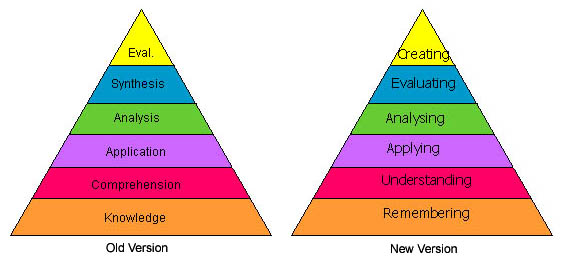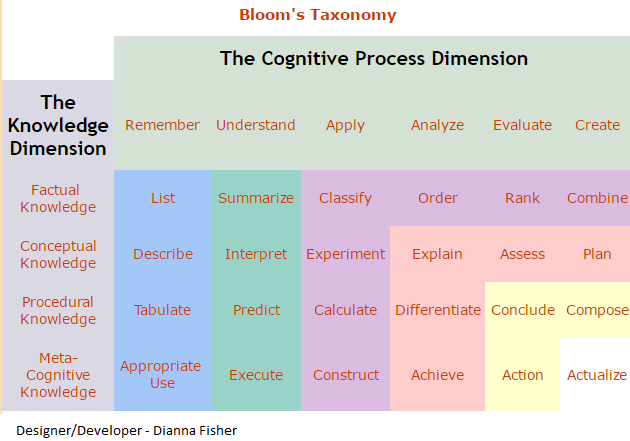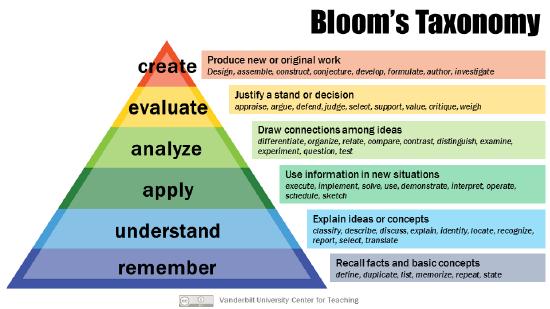Lesson 3.2: Bloom’s Taxonomy
- Page ID
- 10343
\( \newcommand{\vecs}[1]{\overset { \scriptstyle \rightharpoonup} {\mathbf{#1}} } \) \( \newcommand{\vecd}[1]{\overset{-\!-\!\rightharpoonup}{\vphantom{a}\smash {#1}}} \)\(\newcommand{\id}{\mathrm{id}}\) \( \newcommand{\Span}{\mathrm{span}}\) \( \newcommand{\kernel}{\mathrm{null}\,}\) \( \newcommand{\range}{\mathrm{range}\,}\) \( \newcommand{\RealPart}{\mathrm{Re}}\) \( \newcommand{\ImaginaryPart}{\mathrm{Im}}\) \( \newcommand{\Argument}{\mathrm{Arg}}\) \( \newcommand{\norm}[1]{\| #1 \|}\) \( \newcommand{\inner}[2]{\langle #1, #2 \rangle}\) \( \newcommand{\Span}{\mathrm{span}}\) \(\newcommand{\id}{\mathrm{id}}\) \( \newcommand{\Span}{\mathrm{span}}\) \( \newcommand{\kernel}{\mathrm{null}\,}\) \( \newcommand{\range}{\mathrm{range}\,}\) \( \newcommand{\RealPart}{\mathrm{Re}}\) \( \newcommand{\ImaginaryPart}{\mathrm{Im}}\) \( \newcommand{\Argument}{\mathrm{Arg}}\) \( \newcommand{\norm}[1]{\| #1 \|}\) \( \newcommand{\inner}[2]{\langle #1, #2 \rangle}\) \( \newcommand{\Span}{\mathrm{span}}\)\(\newcommand{\AA}{\unicode[.8,0]{x212B}}\)
Mary Forehand (The University of Georgia)
 Figure \(\PageIndex{1}\): Photograph of Benjamin Bloom (Copyright; Wikimedia Commons CC-BY-SA)
Figure \(\PageIndex{1}\): Photograph of Benjamin Bloom (Copyright; Wikimedia Commons CC-BY-SA)
Biography
Introduction
History
Discussions during the 1948 Convention of the American Psychological Association led Bloom to spearhead a group of educators who eventually undertook the ambitious task of classifying educational goals and objectives. Their intent was to develop a method of classification for thinking behaviors that were believed to be important in the processes of learning. Eventually, this framework became a taxonomy of three domains:
What is Bloom’s Taxonomy?
Revised Bloom’s Taxonomy (RBT)
Terminology changes
 Figure \(\PageIndex{2}\): Terminology changes “The graphic is a representation of the NEW verbiage associated with the long familiar Bloom’s Taxonomy. Note the change from Nouns to Verbs [e.g., Application to Applying] to describe the different levels of the taxonomy. Note that the top two levels are essentially exchanged from the Old to the New version.” (Schultz, 2005) (Evaluation moved from the top to Evaluating in the second from the top, Synthesis moved from second on top to the top as Creating.). (Copyright; Lorin Anderson via Carnegie Mellon University)
Figure \(\PageIndex{2}\): Terminology changes “The graphic is a representation of the NEW verbiage associated with the long familiar Bloom’s Taxonomy. Note the change from Nouns to Verbs [e.g., Application to Applying] to describe the different levels of the taxonomy. Note that the top two levels are essentially exchanged from the Old to the New version.” (Schultz, 2005) (Evaluation moved from the top to Evaluating in the second from the top, Synthesis moved from second on top to the top as Creating.). (Copyright; Lorin Anderson via Carnegie Mellon University)
Structural changes
 Table \(\PageIndex{1}\): Bloom's Taxonomy. (Dianna Fisher, via Oregon State University, Extended Campus )
Table \(\PageIndex{1}\): Bloom's Taxonomy. (Dianna Fisher, via Oregon State University, Extended Campus )
Changes in emphasis
Why use Bloom’s Taxonomy?
How can Bloom’s Taxonomy be used?
Included is an article entitled, “Using the Revised Taxonomy to Plan and Deliver Team-Taught, Integrated, Thematic Units” (Ferguson, 2002).

Figure \(\PageIndex{3}\): Bloom's Taxonomy. (CC-BY; Vanderbilt University Center for Teaching)

